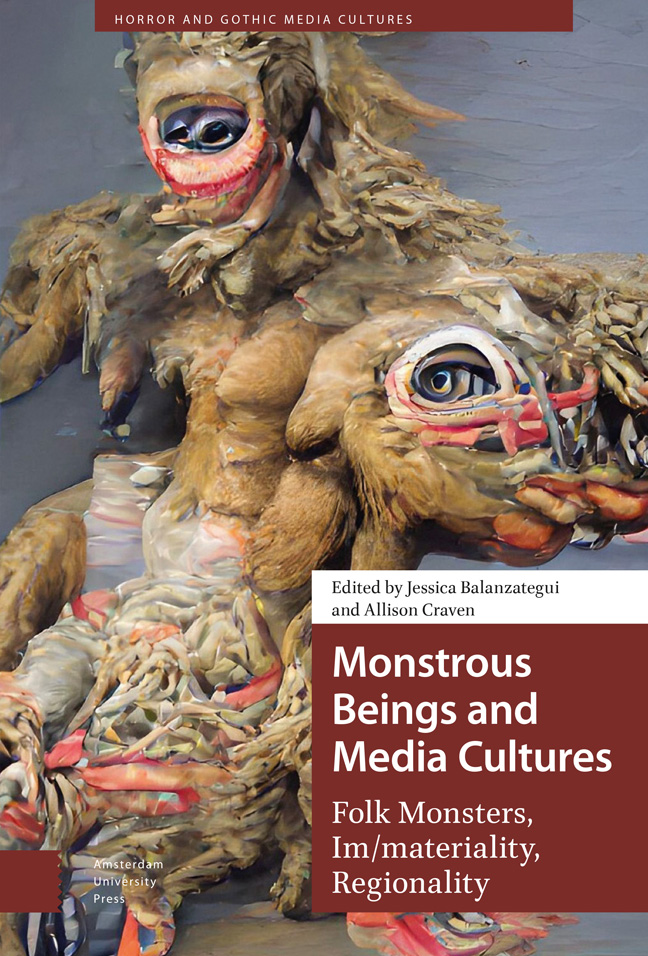Book contents
- Frontmatter
- Contents
- List of Figures
- Acknowledgements
- Introduction: Folk Monsters and Monstrous Media: The Im/materialties, Modalities, and Regionalities of Being(s) Monstrous
- 1 The Momo Challenge as Urban Legend: Child and Adult Digital Cultures and the Global Mediated Unconscious
- 2 “Every Imaginable Invention of the Devil”: Summoning the Monstrous in Eurocentric Conceptions of Voodoo
- 3 The Forest and the Trees: The “Woods” as Intersection between Documentary, Fairy Tale, and Internet Legend in Beware the Slenderman
- 4 Mark Duplass as Mumblegore Serial Killer: Fictional Vernacular Filmmaking in the Creep Series
- 5 Monsters in the Forest: “Little Red Riding Hood” Crimes and Ecologies of the Real and Fantastic
- 6 A Mother's Milk: Motherhood, Trauma, and Monstrous Children in Folk Horror
- 7 Documenting the Unheard: The Poetics of Listening and Empathy in The Family
- 8 Reimagining the Pontianak Myth in Malaysian Folk Horror: Flexible Tradition, Cinema, and Cultural Memory
- 9 An Uncommon Ancestor: Monstrous Emanations and Australian Tales of the Bunyip
- 10 The Folk Horror “Feeling”: Monstrous Modalities and the Critical Occult
- Works Cited
- Mediagraphy
- Index
Introduction: Folk Monsters and Monstrous Media: The Im/materialties, Modalities, and Regionalities of Being(s) Monstrous
Published online by Cambridge University Press: 17 February 2024
- Frontmatter
- Contents
- List of Figures
- Acknowledgements
- Introduction: Folk Monsters and Monstrous Media: The Im/materialties, Modalities, and Regionalities of Being(s) Monstrous
- 1 The Momo Challenge as Urban Legend: Child and Adult Digital Cultures and the Global Mediated Unconscious
- 2 “Every Imaginable Invention of the Devil”: Summoning the Monstrous in Eurocentric Conceptions of Voodoo
- 3 The Forest and the Trees: The “Woods” as Intersection between Documentary, Fairy Tale, and Internet Legend in Beware the Slenderman
- 4 Mark Duplass as Mumblegore Serial Killer: Fictional Vernacular Filmmaking in the Creep Series
- 5 Monsters in the Forest: “Little Red Riding Hood” Crimes and Ecologies of the Real and Fantastic
- 6 A Mother's Milk: Motherhood, Trauma, and Monstrous Children in Folk Horror
- 7 Documenting the Unheard: The Poetics of Listening and Empathy in The Family
- 8 Reimagining the Pontianak Myth in Malaysian Folk Horror: Flexible Tradition, Cinema, and Cultural Memory
- 9 An Uncommon Ancestor: Monstrous Emanations and Australian Tales of the Bunyip
- 10 The Folk Horror “Feeling”: Monstrous Modalities and the Critical Occult
- Works Cited
- Mediagraphy
- Index
Summary
Abstract
The introduction outlines this collection's focus on the affordances of the media environments in which monsters are made and how they are generated by media-specific creative practices as much as the epistemologies or cultures in which they originate. In examining monstrous beings across a diverse range of contexts, this collection illustrates how monsters travel and lurk between vernacular – or what we polemically term “folk” – and formal media cultures. As this chapter and the collection as a whole elucidate, monsters travel through time as well as space, yet their composition and the anxieties that they project are materially inflected by specific cultural, historical, regional, and geographic conditions.
Keywords: monstrosity, materiality, regionality, media cultures, horror
“Monster theory” (Cohen 1996; Weinstock 2020) is often attentive to the media forms in which monsters and monstrousness emerge (for instance, Botting and Spooner 2015; Manning 2018; Weinstock 2020; Davidel 2020). A key premise of this collection concerns the affordances of the media environments in which monsters are made and how the “fantastic bodies” of monsters (Musharbash 2014) – their uncanny corporeality or incorporeality – are the effect of the media and creative practices that generate them as much as the epistemologies or cultures in which they originate. The chapters engage with screen adaptations of monsters from folk and fairy tales, as well as urban legends and a range of popular narratives that circulate in cinematic, televisual, and online modes of horror storytelling. In the spectral semiotics of the digital gothic, monsters embody “a mode of being without ‘materiality’” (Hopps 2013, 2) or forms of “virtual corporeality” (Blank 2013, 106). The powers and horrors of these digital monsters are underpinned by the cultural and poetic operations of networked sociality, highlighting how, even in the case of these ephemeral beasts, monstrosity and the fears it incites are “historically conditioned rather than a psychological universal” (Halberstam 1995, 6). Via diverse media forms, signals, and ecologies, monsters travel and are trafficked through time as well as space, their forms mutating as they transit through various informational systems.
- Type
- Chapter
- Information
- Monstrous Beings and Media CulturesFolk Monsters, Im/materiality, Regionality, pp. 11 - 32Publisher: Amsterdam University PressPrint publication year: 2023

